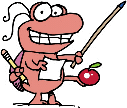
University of Kentucky Department of Entomology








Insects in the Classroom Lesson Plan No. 104
INSECTS A-Z!Prepared by Blake Newton, Extension SpecialistActivity DescriptionInternet or Library Research Objectives
Academic ExpectationsThe above objectives fall under KERA's Science Academic Expectations:
INSECTS A-ZBy finding insect names that begin with each letter of the alphabet and providing information for
each of these insects, students can learn more about the diversity of organisms, characteristics of organisms,
similarities and differences among organisms, lifecycles of organisms, food chains, and other
important principles. The use of the Internet demonstrates the value of the web as a learning tool,
and by providing relevant web addresses students develop an understanding of the importance of
research documentation. Some letters of the alphabet are challenging for this exercise: if extra assistance is needed, there are a couple of places on the net where you can find many insect common names at once:
(student handout) NAME_____________________________ INSECTS A-Z NAMES (26 points; 1 point each): Find 26 insect names, each beginning with a different letter of the alphabet. Find the names of specific insects. For instance: since there are lots of different kinds of butterflies, "butterfly" shouldn't be one of your 26 insects, but "monarch" or "eastern tiger swallowtail" would be acceptable. The Internet should be the easiest place to find these names, although other references may be used as well.
Write a brief description of each insect. Provide at least the following information in just a few sentences:
Provide the web address (e.g., www.uky.edu/webpage.html) of the page where each insect name was found, or the title and the author of any book where the information was found. Find insect names from at least 10 different web sites or other resources.
Write a brief conclusion about your findings. Was it hard to find the names? Did most of the insects have young that were more like worms, or did more of them have young that looked like smaller versions of the adults? Did most of the insects eat plants? Did they eat other insects? Both? Or maybe they ate something else. What was the most unusual insect that you found?
"Teacher Bug" cartoon courtesy of C. Ware, copyright 1999 Document created: May 2001 |
 Return to UK Department of Entomology Katerpillars page
Return to UK Department of Entomology Katerpillars page Return to UK Department of Entomology homepage
Return to UK Department of Entomology homepage Return to University of Kentucky homepage
Return to University of Kentucky homepage